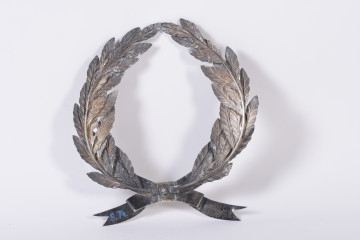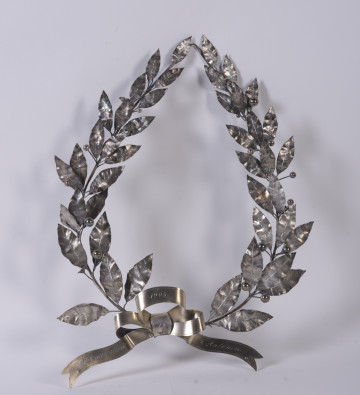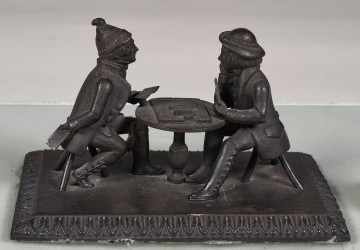
Laurel wreath
XIX/XX wiek
Castle Museum in Łańcut
Part of the collection: Metale
Laurel wreath – a symbol of glory, fame, triumph and victory, also a reward for the victory in a battle or sports competition. It was awarded to victorious leaders, artists, poets, scholars, and athletes. Over the time, the laurel wreath became a symbol not only of victory, but also of outstanding achievements in all areas of life. In the Middle Ages, graduates were honoured with branches of fruiting laurel. A laurel wreath was awarded to outstanding writers (the so-called Capitoline Laurel – a distinction awarded to writers by emperors or popes) , graduates were honoured with branches of fruiting laurel. A laurel wreath was awarded to outstanding writers (the so-called Capitoline Laurel – a distinction awarded to writers by emperors or popes).
In Christian art, laurel wreaths, as symbols of triumph and purity, adorned the heads of holy virgin-martyrs, as well as other martyrs. The laurel wreath also featured the monogram of Christ, indicating his victory over death, or the hand of God, which symbolized his immortality.
In funerary art laurel twigs and wreaths are a symbol of immortality.
As a symbol of glory, the laurel wreath appeared in ancient Greece, but it was the Romans who popularized the custom of crowning emperors and victorious leaders, as well as eminent personalities of science and art, with laurels. Wreaths were also placed on the deceased. In this way, they were provided with the protection of the gods. It was supposed to protect the deceased from misfortunes in the afterlife.
The wreath from the collection of the Museum-Castle in Łańcut comes from the collection of the Potocki and it was created in the 19th/20th century and made in historical Prussia.
The wreath is silver and elliptical. It has inv. no. 71. The wreath, which was used for hanging, is composed of two leafy and fruiting laurel branches, joined at the top by a line, and crossed at the bottom and tied with a gilded ribbon, arranged in a bow in a figure of eight. The ends of the ribbon are triangularly indented, and its edges are modestly decorated with an engraved motif of a double and dotted stripe resembling a tailor's stitch. From behind the ribbon, the bevelled cut ends of the twigs are visible. The leaves are lanceolate, stiff, slightly wavy along the margins, with a delicately marked network of veins. On the front, at the end of the ribbon (on the right side), there is a trademark stamped in Vienna, denoting imported products, valid from 1866 to 1902.
Prussia, 19th/20th century, silver cut, die-cut, partially cast and gilded, engraved, soldered, 39x34.
Yulia Dushka
Author / creator
Object type
metale
Technique
wytłaczanie
Material
brown
Creation time / dating
Owner
Muzeum - Zamek w Łańcucie
Identification number
Location / status

XIX/XX wiek
Castle Museum in Łańcut

Castle Museum in Łańcut

Castle Museum in Łańcut
DISCOVER this TOPIC
National Museum in Szczecin
DISCOVER this PATH
Educational path